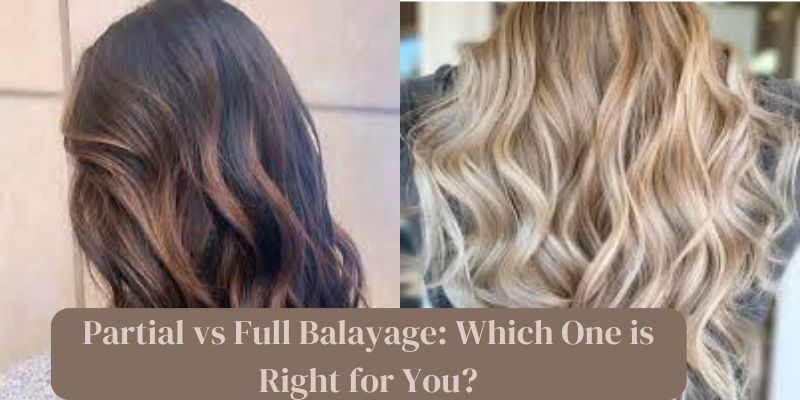When it comes to hair coloring techniques, balayage has gained immense popularity in recent years. This French highlighting technique creates a natural, sun-kissed look that adds depth and dimension to your locks. However, within the realm of balayage, there are two main options to choose from: partial balayage and full balayage. Understanding the differences between these two techniques can help you decide which one is right for you. In this article, we will discuss Partial vs Full Balayage and the characteristics of each technique and provide insights to help you make an informed decision.
Partial vs Full Balayage
Partial
Partial balayage involves applying color to only a select portion of your hair. It typically focuses on the top layers, framing your face and adding subtle highlights. This technique is ideal for those who desire a low-maintenance look or want to experiment with balayage for the first time. Partial balayage offers a softer and more natural effect, allowing for a gradual transition between your natural hair color and the highlighted sections.
Full Balayage
As the name suggests, full balayage encompasses the entire head of hair. This technique provides a more noticeable contrast between your natural hair color and the highlights. Full balayage is suitable for individuals who seek a bolder and more dramatic transformation. It offers greater versatility in terms of color placement, allowing for a more impactful effect throughout your hair. With full balayage, you can achieve a stunning, head-turning look.
Choosing the Right Technique for You
Now that you understand the differences between partial and full balayage, you may be wondering which one is best suited for you. Several factors can help guide your decision-making process:
Desired Look
Consider the final result you wish to achieve. If you prefer a subtle and natural appearance with minimal upkeep, partial balayage might be the right choice. On the other hand, if you want a striking and transformative look, full balayage may be the better option.
Hair Type
Take your hair type into account. Partial balayage can work well on any hair type, whether straight, wavy, or curly. Full balayage, however, is more suitable for those with medium to thick hair, as the contrast between the natural color and highlights is more pronounced.
Maintenance
Evaluate your willingness to maintain your hair color. Partial balayage requires less maintenance as the color is concentrated on specific sections, while full balayage may need more frequent touch-ups to maintain the vibrancy and contrast.
Budget
Consider your budget for hair color services. Full balayage typically requires more time and product, making it a more expensive option compared to partial balayage.
Ultimately, the choice between partial and full balayage depends on your personal preferences and goals. Consulting with a professional hairstylist who specializes in balayage can provide valuable insights and help you determine which technique will best complement your features and lifestyle.
Conclusion
Partial and Full Balayage are two distinct techniques that offer different effects. Partial Balayage creates a soft and natural appearance with minimal upkeep, making it ideal for those seeking a subtle change. Full balayage, on the other hand, delivers a bold and transformative look, suited for individuals who desire a more noticeable contrast. By considering factors such as your desired look, hair type, maintenance preferences, and budget, you can make an informed decision and achieve the balayage style that perfectly suits you.
You may also like:
What is the Best Semi-Permanent Hair Color to Cover Gray?
K18 vs Olaplex: Which is Better for Your Hair?
How Long Does Toner Last and How Often Should You Tone Your Hair?
FAQs
Q:- What is the main difference between partial and full balayage?
Ans:- The main difference between partial and full balayage lies in the coverage of the technique. Partial balayage focuses on highlighting only a select portion of your hair, typically the top layers, while full balayage encompasses the entire head of hair.
Q:- Which balayage technique requires less maintenance?
Ans:- Partial balayage requires less maintenance compared to full balayage. Since the color is concentrated on specific sections, touch-ups are less frequent, making it a low-maintenance option.
Q:- Can I get partial balayage if I have curly hair?
Ans:- Yes, partial balayage works well on all hair types, including curly hair. The technique can add subtle highlights and dimension to curly locks, enhancing their natural beauty.
Q:- Does full balayage work on thin hair?
Ans:- While full balayage can work on thin hair, it tends to be more suitable for medium to thick hair. The contrast between the natural hair color and highlights is more pronounced, creating a bolder effect.
Q:- How much does full balayage typically cost?
Ans:- The cost of full balayage can vary depending on various factors, such as the salon’s location, the stylist’s expertise, and the length of your hair. However, full balayage generally requires more time and product, making it more expensive compared to partial balayage.
